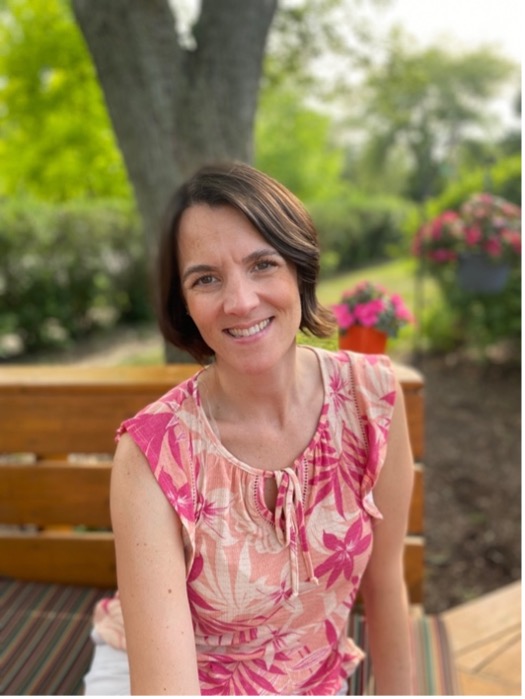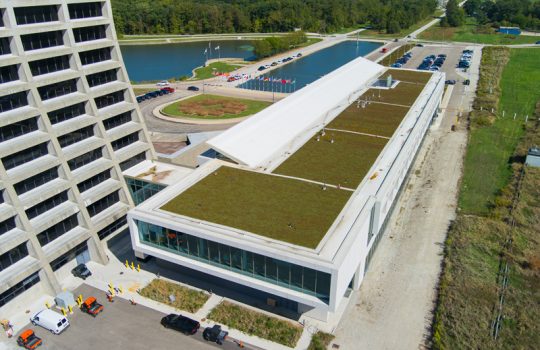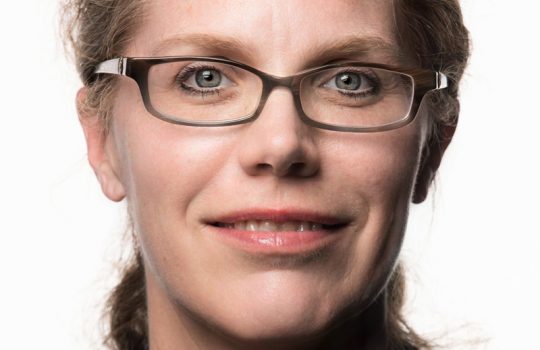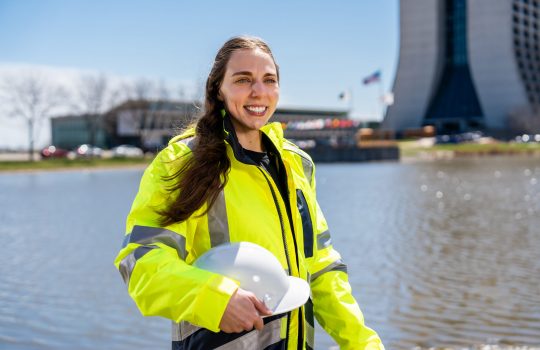
Catherine Hurley, Fermilab’s new sustainability manager who is working to develop a sustainability plan unique to the lab. Photo: Catherine Hurley
What brought you to the U.S. Department of Energy’s Fermi National Accelerator Laboratory?
I was previously at Argonne National Lab working on their sustainability strategy. I joined Fermilab in January 2023, so I’m still very new. I wanted to come and try to help accelerate the great sustainability work going on here at Fermilab.
The lab has long-standing success and commitment to ecological management and preservation of the natural environment. Now, the lab is developing a more robust sustainability program to exceed the sustainability goals set forth by President Biden’s Federal Sustainability Plan. As a sustainably professional, it’s really exciting to work in a place where there’s so much leadership support and a lot of bold visions and interest in making significant progress.
What are some sustainability goals Fermilab is working toward?
Currently, there is a lot of urgency around addressing climate change. The main currency of climate change is carbon emissions because they cause the greatest change to our climate which ultimately causes havoc in pretty much every part of our daily lives.
At Fermilab, over 90% of our carbon footprint is coming from energy usage related to the operation of our high-energy, mission-specific facilities, which include our particle accelerators, so that is a large target area for sustainability practices. We are also working to make individual smaller facilities more sustainable with new building materials and using things like greener, more recyclable products in different experimental areas. But the big sustainability goal for Fermilab is definitely energy efficiency.
What is one of your current projects?
One fairly large project we have going on now aims to identify energy-efficiency opportunities at 14 different buildings. It has the potential to result in sustainable opportunities, like the installation of a solar photovoltaic system with a micro grid. If that were to happen, it would be really great, because we could generate renewable energy on site that would be used immediately by our scientific equipment and help us to be more resilient on site.
What is your role in developing the new sustainability program?
I know lots of general sustainability best practices, but I need to help the team here make a sustainability strategy and program that’s unique and special to Fermilab.
I’ve been really excited to learn how many people have been contributing to this already for over a decade; there’s a whole community of people here that has been doing this for a long time, and they are really passionate. Before we had full-time people, there was the Sustainability Management Team, a rotating committee of people working at Fermilab who had other responsibilities as well. I’ve encountered so many people who are aware that we were working on sustainability and who’ve been on that committee before laying the early groundwork for what we’re doing today.
It’s really great to see how many people care about this topic and how many folks have taken a turn being involved. I’m excited to now bring them more resources by having full-time people to help support that boots-on-the-ground interest.
Is there anything people can do to get more involved?
We are having an internal Earth Day fair on April 20, and I’ll be hosting a booth. It’s the first good opportunity this year to learn about sustainability here at the lab because people can learn about how we’re converting our fleet to electric vehicles, how they can get involved in the bike-share program or how they can participate in employee electric vehicle charging. There will also be people talking about greener products employees can purchase. Just becoming more aware of what’s available is a really great first step.
I’m also going to be at my booth, collecting ideas from people on things that they think we should be pursuing, as well as sustainability successes. I think that a big part of tackling climate change and sustainability is acknowledging our successes in addition to talking about what we can do to be more successful. So, if there are things that people have done in their own work areas or want to do, they should reach out to me — I can help identify more resources and get them better connected into the overall lab activities.
What would you say to someone who feels like committing to sustainability and combatting climate change are hopelessly large challenges?
I always try to tell people to focus on something that you can do with what you have right now, and you can always build upon and do more over time. Although we have these targets we’re trying to hit, sustainability is a journey, not a destination. It’s really a lifelong community and global-scale effort. We’re all working together, so every little effort matters.
Addressing climate change at the lab is a long-term, big, challenging project, but we’ve proven ourselves good at tackling those kinds of projects. We just need to commit ourselves to doing it and then taking it one step at a time, just like we do when we design and implement big science projects. We totally have the right skills; we just need to work together to keep committing to sustainability and tackling climate change.
What do you like to do for fun?
I really like doing outdoorsy things and spending time with my family. I just got back from a spring break trip with my family to the Grand Canyon. I was fascinated by the sheer breadth and depth of the canyon.
And I’m also into crafting and board games and doing social things with friends and family.
Fermi National Accelerator Laboratory is supported by the Office of Science of the U.S. Department of Energy. The Office of Science is the single largest supporter of basic research in the physical sciences in the United States and is working to address some of the most pressing challenges of our time. For more information, please visit science.energy.gov.



